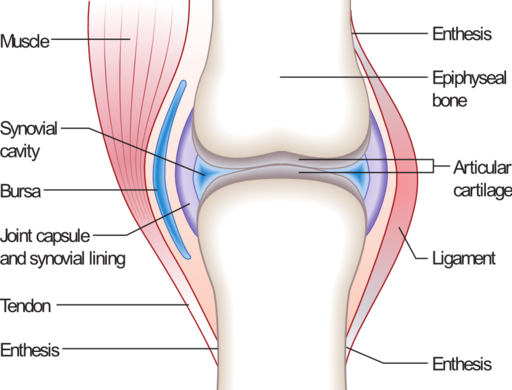
Do your joints make noises, such as snap crackle and pop? Before you can become a joint whisperer, you must get clear about some basic joint anatomy. So, first things first: A joint is the place where two or more bones meet. Without joints your body would be one giant immobile bone.

That said, not all joints allow for movement. Fibrous and cartilaginous joints allow for little to no movement while synovial joints allow movement in many directions. Let’s take a closer look at synovial joints, as they are moving joints we are most often concerned (ankles, knees, hips, shoulders, elbows, wrists). These are the joints that typically create disturbing sounds and sensations during movement – although they are certainly not the ONLY joints capable of noise.
Knowing the structures that are in and around your synovial joints provides a massive clue as to how to interpret the sounds they make. Here is a short list of some of the structures you will find in and around synovial joints:
1) Cartilage – a layer of smooth covering on the ends of the bones that allows them to glide over each other without friction.
2) Sometimes the bones that make up a joint fit together nicely; sometimes they do not. Luckily, your body comes already equipped with spacers, wedges, fatty pads, rings and stuffing to create a better fit and provide some cushioning.
3) Ligaments – fibrous connective tissues that act as straps to hold the bones of your joints together.
4) A bursa (a small sack filled with synovial fluid) is usually positioned between moving parts to reduce friction and keeps things sliding and gliding smoothly (keeping tendon gliding smoothly over bone, for example)
5) A ‘joint capsule’ surrounds and holds the joint together – a connective tissue container lined with a membrane that produces lubricating fluid for your joint.
6) Synovial fluid fills the space inside the joint capsule (like a water balloon) and between the cartilage surfaces. In addition to facilitating smooth, painless movement between bones, it delivers nutrients and oxygen to the cartilage. Joint movement circulates synovial fluid and feeds the cartilage.
Sound typically arises from a joint when something moved out of position or is creating friction. Knowing what’s inside the joint space provides important clues for deciphering the meaning of those snapping, crackling and popping sounds.
Looking for a solution to prime your joints for movement? Try these dynamic Yoga Tune Up® poses: Half Happy Baby Minivini and Pranic Bath
This article is part 1 of a 4-part series on interpreting sounds from the joint space. Come back Friday to learn about synovial joints that snap!
Enjoyed this article? Read This Joint Is Jumping – Getting Comfortable in an Unstable Body











The bursas in my knees have popped pretty much all my life. Would be great to understand a bit more about how to help the joint so that it doesn’t continue happening. It would be interesting to know the difference of sounds between a bursa and joint capsule. Thanks for distinguishing all the supportive areas of the joints that protect them!
Good thing to know… Thank you!
I can’t wait for the reasoning of bone from snapping sound. I heard different reasons from nitrogen escape from body to de-fixation. But I never get a complete scientific explanation. Looking forward to next article
Thanks for such a clear breakdown of the components of a synovial joint! I have crackling in almost all of my joints and am looking forward to reading the rest of the series and potentially deciphering what might be causing that sound!
Thank you for this Amanda! I’m looking forward to reading the rest of this series and diving into my own popping hip. I’ve had it my whole life, it annoys me more than anything and no professional ive mentioned it to has been very concerned about it. With a granny or 2 in our family that’s had a weak hips, I figure it’s a sign of trouble to come. I’m so excited that I might actually be able to alleviate this for myself!
Thank you for shedding more light on the synovial joints Amanda! I often hear the snap, crackle, pop of
various parts while practicing (and teaching) yoga, but never had a clear understanding of what was actually happening!
A great breakdown of Synovial Joints. Incorporating movement with Half Happy Baby Minivini and others helps to refresh and keep the joints working properly. Thank you!
Thanks Amanda, great article in explain what makes a snap. I always had a snap at my hip, never knew exactly what was causing it so this gives me a good idea.
Thank you Amanda for this informative article. I have a lot of clicking/clunking around the hip joint (no pain). Nice to have an explanation that is easy to understand.
Wow for this great article Amanda. The synovial joint is so clearly explained. Shall read it again!
Thanks Amanda for this explanation! My right hip has the tendency to “pop”, but until now I could not really explain the sound. Time to go explore: read your other parts on this subject and do some research on the hips. Thanks again for inspiring!
I want thank Amanda for this subject ! I am now aware of what create that littles cric and crac in knees and cie ! And have now a reference ! Merci !
Yes, everybody’s life is filled with snap crackles and pops. I didn’t enjoy them in my younger days but come to appreciate 99% of them nowadays as most feel like a delicious release. However there certainly are a few sounds and sensations that I wonder about in a not-so-enjoyable way.
This is a great primer and I look forward to continuing the series in 5, 4, 3, 2, 1….
So, snap, crackle and pop have been part of my life for awhile and are rather disturbing. Nothing hurts, but the noise ranges from what I can only hear to the yoga instructor saying — “is that your legs again Pam?” Seriously!! Amanda, your blog was helpful for me beginning to understand what is going on inside my hips and legs. The noise usually is most intense in eagle and in low lunges. I’ll continue to read this series to see what else I can learn.
Thanks for the anatomy refresher. I get asked frequently “why does my shoulder/knee/hip make those noises”. “Is that normal?” I will definitely read your other blogs to see what your point of view is? Hopefully it will give me insight for my patients. My prediction is that muscle imbalance may play a big role.
I feel like the “snap, crackle, pop” conversation is one that comes up fairly regularly. Among teacher & students alike- some say it’s no big deal, others say it is, others say that it only counts if it hurts. I don’t know- but I do know that I snap crackle pop a lot & sometimes it stops me from moving. Unpacking the joint structure definitely gives me a new perspective, at the very least, something to think about .
i have osteoarthritis in one knee and it makes a sound when i go up stairs, like a friction sound. Always keen to learn more about whats going on inside my body.
I am really enjoying learning about the possible causes of bodily sounds and how we can treat our bodies to be quieter.
I have lots of sounds in different joints and I never thought it could be to the different structures. Now I will try to decipher the sound and will read the follow up blogs too.
Thanks for the useful information! I will continue to read the rest of the series as I do have popping sounds in my ankles, knees, and upper arms.
A great article explaining the potential causes for the the snapping, crackling and popping sound in the joints. I do have these sounds in the middle of both of my upper arms, and they are also accompanied with pain. Because of the pain position, I always thought there was something wrong with the triceps. I will continue to read the remaining of this series to understand more about these sounds. Thanks!
Thank you for a simple breakdown of the structure of synovial joints. The description ” spacers, wedges, fatty pads, rings and stuffing” helps gives me a better picture.
Amanda this was a GREAT article breaking down what goes on around/in the joint. I have a much better insight to what is going on in the area surrounding our joints and what could be causing these sounds. Working with the roll model balls I get many cracks in my shoulders and T-Spine area. I look forward to reading the next few articles that break down the snap, crackle, and pop (I call my shoulders rice krispie shoulders because of the snap, crackle, and pop!).
This simple explanation of the noise in the joints is perfect and easier for me to communicate to my clients. I look forward to reading the next blog. Now I’m curious to see if anyone has written on why some knees crack more going up the stairs and some crack more going down the stairs.
Awesome, thanks Amanda! “Why does my joint make sounds? Is that bad?” is such a common question I hear. This little anatomy lesson on the joint really helps me to get started answering questions like this.
The snap,crackle and pops in minivini’s I realised were not to be feared, I was guarding my pain, but with attention to breath and the slow to start movements my body started to let go of pain and my mind too. Much deacreased pain levels heading into day 3 of training. Thank you so much.
Students are always asking if it’s ok if their joints “snap crackle and pop”. While there is always conflicting information out there, it’s always good to know the anatomy of the joint – that can’t be disputed. From that understanding, one can interpret what is really going on.
I’ll keep reading on the other three tomorrow and this is so helpful in understanding how the joints work. And I’m glad you explained what bursa is because I was confused whenever this term was mentioned during the training. I’ll stay tuned!
Thanks for the review of the different parts that make up a joint. I have a lot of cracking and snapping and am curious to read your other articles to see what additional exercises could help improve joint stability.
I make a lot of these noises during my chiropractic adjustments. And my chiropractor always says “that’s good, fantastic”! They sound scary though! I guess they’re ok since I feel well after… Any thoughts?
This article makes me more aware of my snap, crackle and pops–when to really pay attention. Thank you for the simplicity in which you present the material.
Great break down. Anatomy can feel overwhelming. Simplification helps. Thank you.
Great way of breaking down the anatomy behind the popping. I’ve always wondered why my knees and hips excessively pop and this is a great first step to figuring out the cause behind it all. Thanks for the info! I’m definitely going to read the other articles in this series.
Thanks for the instructive primer- on to part 2 …. She said cracking her knuckles
So often we hear from instructors to just embrace the sounds that your joints make. When it’s broken down like this, and explained in detail, it’s obvious that we need to listen more and investigate if it really is a sign of something more! Thank you for this information!!
Very interesting. My knees are cracking for many years as long as i remember my self without causing any pain or discomfort except the sound 🙂 Going to read next articles
As I rotate my ankles reading this article, I can’t wait to get to part 2… the snapping! Loving this take on the joints, its a common question from students… why is my body making these noises?
Thank you for your clear and simple overview of the joints. For people who are just learning about the anatomy in greater detail (like I am!), this detailed explanation is extremely useful. I myself have lots of crackles and pops, so I will be reading the rest of this series.
A great review on joints and how the bones come together to form the joints. One line caught my eye, ‘joint movement circulates synovial fluid’. I have heard many times in yoga classes that joint articulation or weight on the joints CREATES synovial fluid and for along time was never sure if this was correct. I looked this up and learned about synovial fluid and realized that we CIRCULATE fluid when moving joints not create more. All the better reason to maintain nice and juicy joints, there isn’t more where that came from!
Looking forward to reading more of your installments. I want to be a joint whisperer!
Huge lightbulb moment when I realized that the clicking, ticking and sputtering sounds I hear from my shoulders are coming from weakness and instability. Just because you’re “flexible” doesn’t mean your joints are lubricated and the muscles that surround the joint are strong enough to support it. I have a whole new world to explore with this…
We talked about snap, crackle and pop yesterday in our training course while doing pranic bath. I hadn’t thought about what is actually happening in the joint while these sounds occur. I guess I knew that tendons may snap across the bone but I hadn’t considered that soemthing was out of place (it’s so obvious now that I write this). Jill mentioned creating more strength around the joint and yesterday and doing a smaller range of motion while doing pranic bath.
Snap, crackle, pop! I do all three in several joints and just thought it came along with grey hair and wisdom 🙂 Will keep reading…
This is a helpful outline of all the parts that make up the joint. I’m interested to read all the others as I have a client who has really bad popping/clicking noises at his knees whenever he comes into a lunge. I’ll read on to find out more 🙂 Also, is movement at the joint the only thing that circulates synovial fluid? Is it like lymph, which has no “heart” other then our own movement to pump it through the body, or in this case, the joint?
A great reminder of the importance of synovial fluid, and a good motivation to hop on the mat, or wherever is good!, to get that lubricating fluid flowing! It can help right now, and in the future by reducing friction and preventing pain- a win:win!!
Appreciate the thoroughness and simplicity of the explanation of basic joint anatomy. Helps to have it condensed to make it a little nugget of wisdom to incorporate into the every expanding knowledge base of the body.
Sound is created when something is moved out of place and creates friction. Thanks! I will read on!
Nice explanation of the anatomy of the joint. Now I’m looking forward to discovering all the reasons they may make those different sounds. Sounds like knowing the structure will be the first clue in knowing whats going on with that pop.
This gives a great “lay of the land” of joints to better assess what might be the cause of the commotion 🙂 thank you for this detailed article!
Thanks for explaining the causes of these cracks and pops. I am curious to investigate more into why certain areas of my body crack, this article will help take me in the right direction.
Thanks Amanda, I like the breakdown of potential offenders 🙂 My clients are always asking about popping and crackling.
Good luck, Marsha Marsha Marsha!
Amanda! I discovered I have a lot of snap, crackle, and pops in my shoulders when I move them around, especially flexing overhead as in tadasana. This is a great intro article to understanding what’s going on in my joints! I look forward to learning more about how to understand and/or get rid of them! Haha! Right now, I’m working on rolling out my (right) latissimus dorsi with the Roll Model® massage therapy balls because I noticed the tightness that runs from my scalenes through my upper trapezius to my rotator cuffs. Wish me luck in discovering more!!
Thank you Amanda for this informative blog. I’m looking forward to the entire series. You made it really easy to understand how all the surrounding architecture supports the joint.